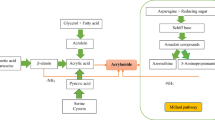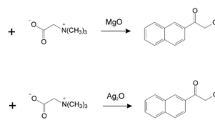Abstract
Analytical methods currently employed for determination of acrylamide (AA) in two carbohydrate-rich food samples, crispbread and butter cookies, obtained commercially, and native and spiked bread extract samples have been evaluated in a collaborative study. The objective of the study was to obtain information about the performance of the participating laboratories when analysing samples with an AA content close to the limit of quantification (LOQ) and at a higher AA level, and to investigate the influence of sample-preparation procedures on the results of the analysis. For this purpose an aqueous native extract of white bread crumb, a fortified extract, and AA standard solutions, the analyte content of which were not disclosed to the participants, were included in the study. A total of 62 laboratories, applying seven different measurement techniques and a broad spectrum of analyte extraction and sample-preparation procedures reported their analytical results. Because the measurement data were not normally distributed, they were evaluated by application of robust statistics. The relative performance of the laboratories was highlighted by calculation of z-scores. For the crispbread sample, especially, a large percentage of the calculated z-scores were outside the satisfactory range. From their distribution it became obvious that one of the analytical techniques might be biased, if not applied correctly. Consequently, the impact of the applied methods was examined in more detail. Information about the analytical technique, extraction solvent, quantity weighed, calibration method, clean-up, and the experience of the participating laboratories were extracted from the analytical protocols and transcribed into a data matrix which was evaluated by multifactor analysis of variance. The applied measurement technique seems to have a statistically significant influence on the analytical results.







Similar content being viewed by others
References
Hagmar L, Törnqvist M, Nordander C, Rosén J, Brunze M, Kautiainen A, Magnusson AL, Malmberg B, Aprea P, Granath F, Axmon A (2001) Scand J Environ Health 27:219–226
International Agency for Research on Cancer (IARC) (1994) IARC Monographs on the evaluation of the carcinogenic risk of chemicals to humans: some industrial chemicals, Lyon, 60:389–433
Johnson K, Gorzinski S, Bodner K, Campell R, Wolf C, Friedman M, Mast R (1986) Toxicol Appl Pharmacol 85:154–168
EEC Directive 92/39/EEC, 1992 L330:21–29
EEC Directive 98/83/EC, 1998 L330:32–54
FAO/WHO Acrylamide Infonet:http://www.acrylamide-food.org/index.htm
European Commission: Acrylamide in food – database of activities in the EU:http://europa.eu.int/comm/food/fs//sfp/fcr/acrylamide/acryl_database_en.html
Rosén J, Hellenäs KE (2002) Analyst 127:880–882
Tareke E, Rydberg P, Karlsson P, Eriksson S, Törnqvist M (2002) J Agric Food Chem 50:4998–5006
Castle L (1993) J Agric Food Chem 41:1261–1263
Castle L, Campos M-J, Gilbert J (1991) J Sci Food Agric 54:549–555
Biedermann M, Biedermann-Brem S, Noti A, Grob K, Egli P, Mändli H (2002) Mitteilungen Lebensm Hyg 93:638–652
Wenzl T, de la Calle MB, Anklam E (2003) Food Addit Contam 20:885–902
de la Calle MB, Ostermann O, Wenzl T, Anklam E (2003) EUR 20766 EN, to be downloaded from:http://www.irmm.jrc.be/ffu/acrylamide.html
Fauhl C, Klaffke H, Mathar W, Palvinskas R, Wittkowski R (2002) Acrylamide interlaboratory study 2002, to be downloaded from:http://www.bfr.bund.de/cms/detail.php?template=internet_de_index_js
Clarke DB, Kelly J, Wilson LA (2002) J AOAC Int 85:1370–1373
Tareke E, Rydberg P, Karlsson P, Eriksson S, Törnqvist M (2000) Chem Res Toxicol 13:517–522
Nemoto S, Takatsuki S, Sasaki K, Maitani T (2002) J Food Hyg Soc Jpn 43:371–376
Becalski A, Lau BPY, Lewis D, Seaman SW (2003) J Agric Food Chem 51:802–808
Thompson M, Wood R (1993) J AOAC Int 76:926–940
Analytical Methods Committee (1989) Analyst 114:1693–1697
Thompson M (2000) Analyst 125:385–386
Horwitz W, Kamps LR, Boyer KW (1980) J AOAC 63:1344
Jadwiszczak P (2003) Random Projects 2.0 LITE. Statistical software available from the web sitehttp://pjadw.tripod.com
Good PI (1999) Resampling methods. A practical guide to data analysis. Birkhauser, Boston
Author information
Authors and Affiliations
Corresponding author
Rights and permissions
About this article
Cite this article
Wenzl, T., de la Calle, B., Gatermann, R. et al. Evaluation of the results from an inter-laboratory comparison study of the determination of acrylamide in crispbread and butter cookies. Anal Bioanal Chem 379, 449–457 (2004). https://doi.org/10.1007/s00216-004-2591-4
Received:
Revised:
Accepted:
Published:
Issue Date:
DOI: https://doi.org/10.1007/s00216-004-2591-4




